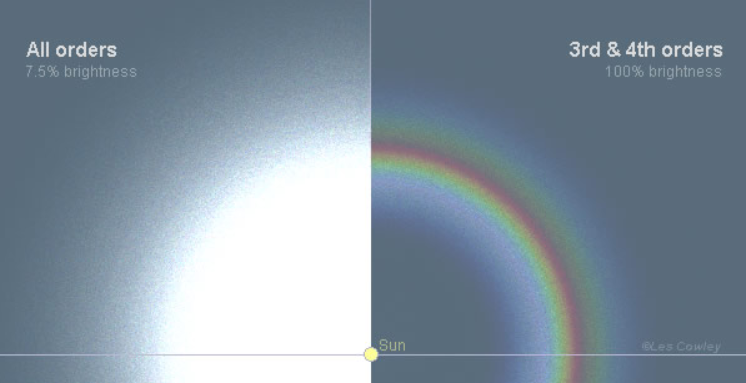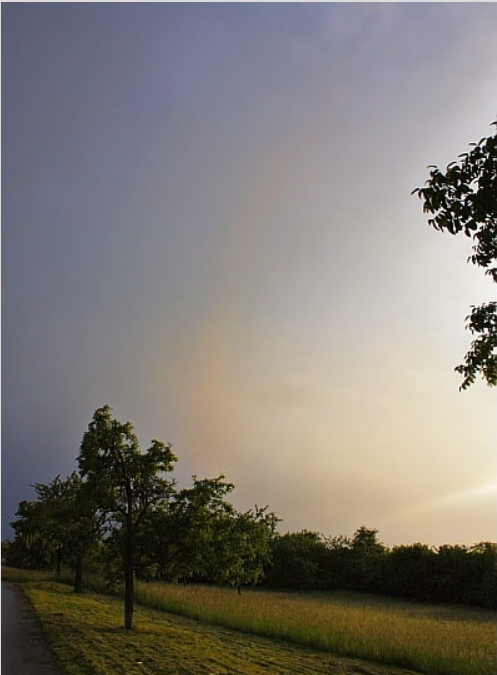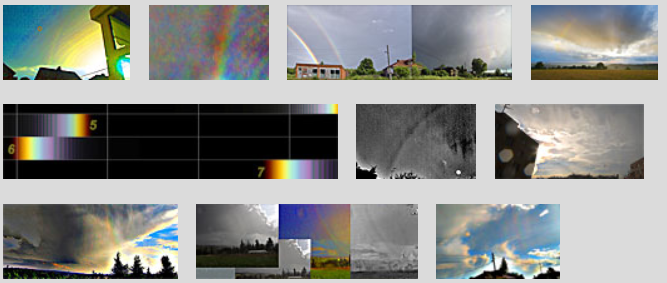3rd and 4th Order Rainbows
Exploring the Fascinating World of 3rd and 4th Order Rainbows
Rainbows have captivated our imagination for centuries with their vibrant colors and ethereal beauty. While most of us are familiar with the primary and secondary rainbows, there exist rarer and more elusive phenomena known as 3rd and 4th order rainbows. These rainbows, formed by multiple internal reflections within raindrops, offer a mesmerizing glimpse into the complexity of atmospheric optics.
Unveiling the Tertiary Rainbow
The tertiary rainbow, also known as the 3rd order rainbow, is a fascinating celestial phenomenon that has been observed and documented by dedicated individuals. Unlike the primary and secondary bows, which appear opposite the sun and are centered on the antisolar point, the tertiary rainbow presents itself sunwards and is centered on the sun. With a nominal radius of approximately 42.5 degrees, it is similar in size to the primary rainbow but broader in appearance.
While one might expect the tertiary bow to be easily visible due to its significant brightness, several factors make its observation challenging. Firstly, its light is overshadowed by the intense glare generated by rays passing through raindrops without internal reflection, known as the zero order glow. Secondly, the broader nature of the tertiary rainbow results in a lower luminosity per unit solid angle of the sky, further reducing its visibility. Lastly, the presence of glare and scattered light from the nearby sun interferes with its observation.
The First Known Image of a Natural 3rd Order Rainbow
The sighting and subsequent photographic documentation of a natural 3rd order rainbow was a groundbreaking achievement in atmospheric optics. On May 15, 2011, Michael Großmann, an avid rainbow enthusiast in Kämpfelbach, Germany, observed a rain shower approaching from the north. As he blocked the sun with a tree and carefully observed the sky, he noticed a faint shimmering trace of a bow for approximately 30 seconds. He quickly captured an image, which, after careful analysis and verification, confirmed the presence of the long sought-after tertiary rainbow.
Michael Großmann's success in capturing the first known image of a natural 3rd order rainbow can be attributed to his meticulous observation skills, camera preparation, and intimate knowledge of where and what to look for. His achievement paved the way for further exploration and study of these elusive atmospheric phenomena.
Discovering the 4th Order Rainbow
In addition to the 3rd order rainbow, there exists an even rarer phenomenon known as the 4th order rainbow. This bow is formed by four internal reflections within raindrops and exhibits reversed colors compared to the primary rainbow. Its brightness is approximately 15% of that of the primary rainbow. Just a month after Großmann's discovery, Michael Theusner successfully photographed a natural 4th order rainbow, further expanding our understanding of these intricate optical phenomena.
The Growing Number of Sightings
With the advent of modern cameras and advanced post-processing techniques, the sighting and documentation of 3rd and 4th order rainbows have become more frequent. Once considered rare occurrences, these higher-order rainbows have been captured by numerous photographers around the world. The success of subsequent sightings can be attributed to the pioneering work of individuals like Michael Großmann, who demonstrated the feasibility of observing and photographing these elusive phenomena.
Capturing Your Own Images
If you're eager to witness and capture the beauty of higher-order rainbows, it requires perseverance, a willingness to get wet, and knowledge of where to look. Here are some tips to increase your chances of capturing these elusive atmospheric phenomena:
- Look for bright primary and secondary rainbows as they are a good sign.
- Ensure rain is falling in the direction you are observing.
- The 3rd order rainbow is typically located two outstretched hand widths from the sun.
- Seek a uniform dark cloudy sky in the direction of the tertiary bow for optimal visibility.
- Shield the sun using natural or artificial objects such as clouds, buildings, or camera shields.
- Use a relatively wide-angle lens and ensure it is clean and free from raindrops.
- Take multiple shots and consider stacking techniques to enhance the visibility of the rainbow.
- Learn from other photographers' image processing techniques but avoid excessive saturation or contrast enhancement.
- Remember, if a feature does not appear faintly in the original image, excessive enhancement will not reveal it.
While the opportunity to witness higher-order rainbows may be rare, with patience, preparation, and a little luck, you too can capture the enchanting beauty of these elusive atmospheric phenomena.
So, embrace the challenge, explore the skies, and may luck be on your side as you embark on your own journey to discover the wonders of 3rd and 4th order rainbows!

3rd & 4th order rainbows.
This BowSim simulation, made by tracing several hundred million rays through a raindrop, looks towards the sun.
On the left is an unfiltered view. All that can be seen is the white glare of the zero order glow surrounding the sun.
The filtered view at right shows only the rays making the 3rd order (inner) and 4th order (outer) rainbows.
Updated - Scroll down.. Rays leaving raindrops after three reflections produce a tertiary rainbow. Unlike the primary and secondary bows which are opposite the sun and centered on the antisolar point, the tertiary appears sunwards and is centered on the sun. With a nominal radius of 42.5º it is similar in size to, but broader than, the primary bow.
The tertiary bow's total brightness is 24% of the primary bow. We might therefore think that it ought to be easily visible. There are severe difficulties: (1) its light is swamped by that of rays that pass through raindrops without any internal reflection. These generate an intense glare around the sun, the zero order glow, (2) the tertiary is broader than the primary and secondary, thus its luminosity per unit solid angle of sky is correspondingly less, (3) glare and scattered light from the nearby sun interferes.
First ever image of a natural 3rd order bow
There were one or two early reports of visual sightings, the most significant by Pedgley.. But no photographs existed.
All that changed on the evening of May 15, 2011 when Michael Großmann at Kämpfelbach in SW Germany saw a rain shower approaching from the north. Primary and secondary bows were visible. The rain intensified at his camera position. It was also falling sunward and a dark cloud reduced the brightness of the near-sun sky. Michael blocked the sun with a tree and thought he could see a faint shimmering trace of a bow for 30 seconds. He took a picture and after processing it showed a definite rainbow!
Subsequent very critical and careful analysis confirmed the sighting (Photographic evidence for the third-order rainbow, M Grossmann, E Schmidt, & A Haussmann, Applied Optics, Vol. 50, Issue 28, pp. F134-F141 (2011)). Michael Großmann had made a special study of rainbows and his success came from painstaking observation, camera preparation and most important of all, knowing just where to look and what to look for.

Großmann's 3rd order rainbow - The first known image. Star field calibration and computation of the sun position and angular properties of the image verified that the coloured arc was indeed the long sought tertiary rainbow. Images ©Michael Großmann, shown with permission
4th order bow also seen
The 4th order bow (four internal reflections) is close to the 3rd order but with reversed colours. Its brightness is only 15% of that of the primary. That was photographed by Michael Theusner (Photographic observation of a natural fourth-order rainbow, M Theusner, Applied Optics, Vol. 50, Issue 28, pp. F129-F133 (2011)) only a month after Großmann's triumph.
Many more sightings
Somehow things are easier once they have been done once. Previously unconquered mountains get thronged with climbers. Now, the 3rd, 4th and even 5th order rainbows have been photographed several times. Modern cameras and advanced post processing contribute – plus knowing that it is possible.
Click these thumbnails for sightings in roughly chronological order. Check OPOD for new ones.

And indoors

Image them yourself
Perseverance, willingness to get wet and knowing where to look are needed more than anything else. Even ‘ordinary’ primary and secondary rainbows are relatively infrequent and the right conditions to capture the elusive higher orders are more so. Do not search during a thunderstorm!
Bright primary and secondary bows are a good sign. Then look sunwards. Rain must be falling in that direction. The 3rd order bow is two outstretched hand widths from the sun. Uniform dark cloudy sky in that direction is best. The sun itself should be shielded by a small cloud, a building or a special camera shield.
Use a relatively wide angle lens. The lens must be clean with no raindrops – make a box for the camera or otherwise shield it. Above all, no sun on the camera. Take many shots. Think maybe about stacking. Look how other observers have processed their images. Avoid grotesque over saturation or contrast enhancement. In general, if a feature does not show faintly on an original image, over 'enhancement' will not show it.
Good luck!
. D E Pedgley reported sighting the 3rd order bow in Nairobi and described it in Weather (Weather 41, 401 (1986)) "Whilst in Nairobi recently I had the good fortune to see a tertiary rainbow. On 21st May 1986 at 17.55 a new shower cloud had just started to rain out over my hotel in dense curtains of medium sized drops brilliantly lit by the low sun. From the balcony of my fourth floor room I could see not only a bright primary, accompanied by a moderate secondary, but also a weak bow in the direction of the sun, which was conveniently shielded by the side of the building. The bow was scintillating but distinct for two or three minutes. It was about the same size as the primary bow, with red on the outside and green on the inside."
Note: this article has been automatically converted from the old site and may not appear as intended. You can find the original article here.
Reference Atmospheric Optics
If you use any of the definitions, information, or data presented on Atmospheric Optics, please copy the link or reference below to properly credit us as the reference source. Thank you!
-
<a href="https://atoptics.co.uk/blog/3rd-and-4th-order-rainbows/">3rd and 4th Order Rainbows</a>
-
"3rd and 4th Order Rainbows". Atmospheric Optics. Accessed on April 27, 2024. https://atoptics.co.uk/blog/3rd-and-4th-order-rainbows/.
-
"3rd and 4th Order Rainbows". Atmospheric Optics, https://atoptics.co.uk/blog/3rd-and-4th-order-rainbows/. Accessed 27 April, 2024
-
3rd and 4th Order Rainbows. Atmospheric Optics. Retrieved from https://atoptics.co.uk/blog/3rd-and-4th-order-rainbows/.